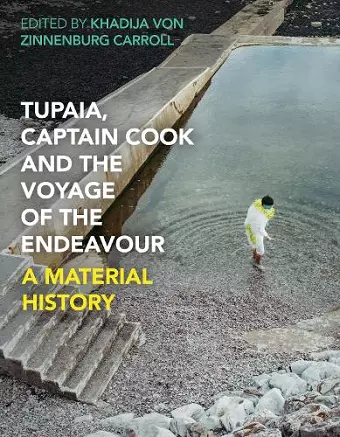Tupaia, Captain Cook and the Voyage of the Endeavour
A Material History
Khadija Von Zinnenburg Carroll editor
Format:Hardback
Publisher:Bloomsbury Publishing PLC
Published:27th Jul '23
Currently unavailable, and unfortunately no date known when it will be back

Redressing Captain Cook's Endeavour voyage and centering the navigator, Tupaia, this book brings together indigenous perspectives to explore material history alongside acts of commemoration in Britain and the Pacific.
Centring priest and navigator Tupaia and Pacific worldviews, this richly illustrated volume weaves a new set of cultural histories in the Pacific, between local islanders and the crew of the Endeavour on James Cook’s first ‘voyage of discovery’ (1768-1771). Contributors consider material collections brought back from the voyage, paying particular attention to Tupaia's drawings, maps, cloth and clothes, and the attending narratives that framed Britain’s engagement with Pacific peoples.
Bringing together indigenous and Pacific-based artists, scholars, historians, theorists and tailors, this book presents a cross-cultural conversation around the concepts of acquired and curated artefacts that traversed oceans and entwined cultures. Each chapter draws attention to a particular material, object or process to reveal fresh insights on the voyage, the societies it brought together and the histories it transformed. Authors also explore animal iconography, instruments and ethnomusicology, and performances and rituals.
This work challenges colonial museum collections and celebrations of Cook’s voyages, using materials old and new to make connections between past and present, whilst reinforcing Tupaia’s agency as both a historical figure and a contemporary muse. Tracing overlapping folds of symbolism, this book draws together a picture of the diverse materials and people at the centre of cultural exchange.
The book provides an enlightening alternative prism through which we can rediscover the Pacific agency in Tupaia, beyond the gaze of the dominant colonial history, which often revolves around Captain Cook’s view of the world. It is a must-read collection of narratives woven together into an intellectually illuminating tapestry of cultural history with a strong Pacific flavour. A highly recommended text. -- Steven Ratuva, Distinguished Professor and Director of the Macmillan Brown Centre for Pacific Studies, University of Canterbury, Aotearoa New Zealand
This set of essays does not result in a history, nor in a re-evaluation of previous histories but instead it is a tapestry of relations, of conversations and reflections on the Ra’iatean navigator Tupaia. This contemporary engagement with Tupaia redresses thin colonial understandings of his role with layers of social fabric that emerge from the multivocality of the volume’s authors, including established and emerging artists, scholars, filmmakers and composers. From multiple vantage points, the authors reveal that the strength of material culture, in this case the cloaks of Tupaia and Cook, is in their relationship to the intangible, the cross-temporal, the sonic, the performative, and how these make kin of all involved. -- Kathryn Bunn-Marcuse, Director of the Bill Holm Center, Burke Museum of Natural History and Culture and Associate Professor of Native Art, University of Washington, USA
As European institutions remain trapped by their colonial legacies, this book documents a funeral procession for the great navigator Tupaia, that walked from the doors of the National Maritime Museum to the ocean over which he guided Captain Cook, from the bowels of Europe’s collections to the air of living Polynesian history. -- Darren Jorgensen, Associate Lecturer, University of Western Australia
Using dress to redress historical ignorance about the significance of Tupaia during Cook’s Endeavour voyage, this volume is a multivocal assemblage of perspectives and reflections that demonstrate the ongoing challenges and complex legacies that stem from early colonial encounters. Not only do the authors demonstrate the potency of clothing in restoring Tupaia’s absence from the historical record, they also address questions of ownership of museum collections. The volume interweaves social relationships in a realm of dialogue in which all voices act as co-interpreters. Divided in two sections, one analysing the manifold histories of Tupaia, the other honouring Tupaia by describing the Cook’s New Clothes project, this book presents a mosaic of interpretations that cross geographical, temporal and disciplinary boundaries, as such providing a true testimony to the complexity and command of the figure of Tupaia himself. -- Karen Jacobs, Associate Professor in the Arts of the Pacific, University of East Anglia, UK
This rich and wonderful book exemplifies the explosion of research, reflection and creative practice around European maritime exploration over the last thirty years. Building especially on the work of Anne Salmond, commemorative studies of celebrity navigators such as Captain Cook have been succeeded by critical inquiry into cross-cultural voyaging, the deep histories of collecting, projects to return artefacts from institutions such as the Museum of Archaeology and Anthropology in Cambridge to Australia, Aotearoa and Tahiti, and art practices that re-imagine encounters towards postcolonial futures. The Society Islands priest, artist and navigator Tupaia has been at the heart of these studies. This book offers a key set of debates and contributions that will be widely valued. -- Nicholas Thomas, Director of the Museum of Archaeology and Anthropology, University of Cambridge, UK
ISBN: 9781350157491
Dimensions: 250mm x 192mm x 20mm
Weight: 900g
240 pages